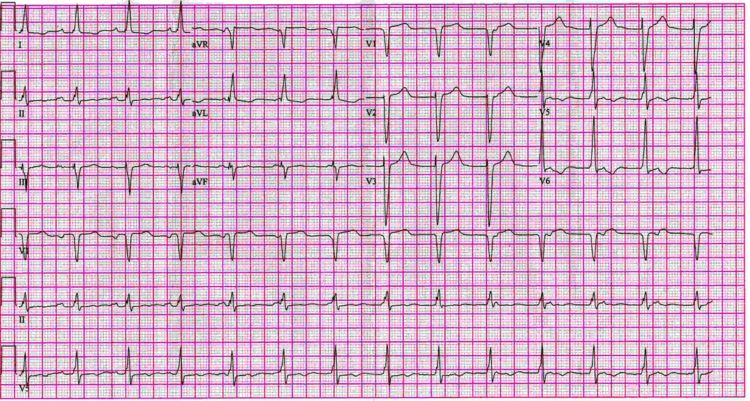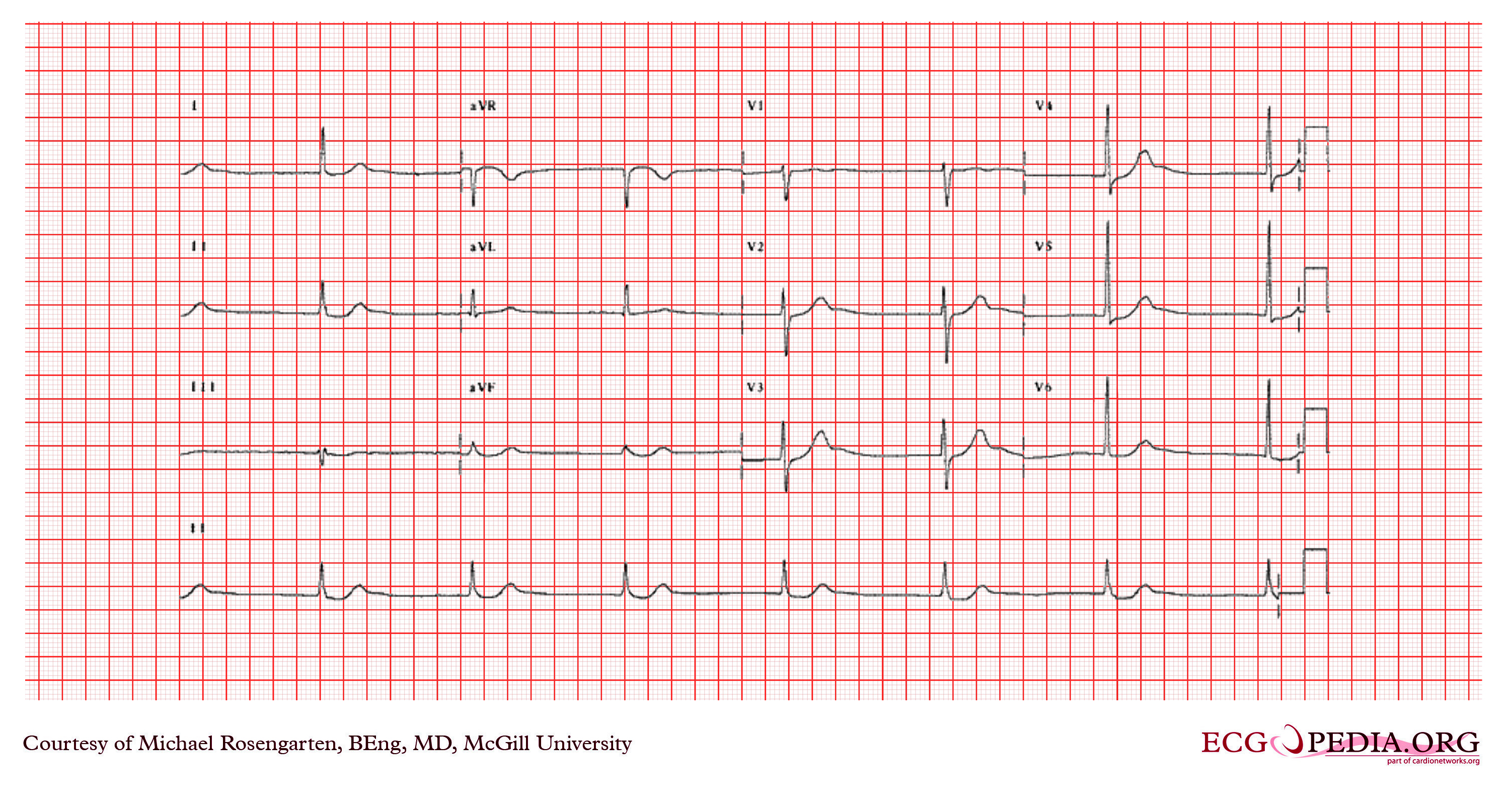Junctional rhythm: Difference between revisions
| Line 25: | Line 25: | ||
=== Pathogenesis === | === Pathogenesis === | ||
In junctional rhythm, | |||
* In junctional rhythm, the heart beats rate are not controlled by the sinoatrial node. The new pacemaker in the junctional rhythm is the atrioventricular node.<ref> eMedicine:"Junctional Rhythms" http://www.emedicine.com/MED/topic1212.htm </ref> | |||
* The atria contracts before the ventricles but from a different signal. The impulse contracting the atria comes from the ventricles not the normal impulse coming from the sinoatrial node.<ref> medical dictionary http://medical-dictionary.thefreedictionary.com/retrograde+conduction</ref> | |||
==Causes== | ==Causes== | ||
Revision as of 03:12, 13 April 2020
|
WikiDoc Resources for Junctional rhythm |
|
Articles |
|---|
|
Most recent articles on Junctional rhythm Most cited articles on Junctional rhythm |
|
Media |
|
Powerpoint slides on Junctional rhythm |
|
Evidence Based Medicine |
|
Cochrane Collaboration on Junctional rhythm |
|
Clinical Trials |
|
Ongoing Trials on Junctional rhythm at Clinical Trials.gov Trial results on Junctional rhythm Clinical Trials on Junctional rhythm at Google
|
|
Guidelines / Policies / Govt |
|
US National Guidelines Clearinghouse on Junctional rhythm NICE Guidance on Junctional rhythm
|
|
Books |
|
News |
|
Commentary |
|
Definitions |
|
Patient Resources / Community |
|
Patient resources on Junctional rhythm Discussion groups on Junctional rhythm Patient Handouts on Junctional rhythm Directions to Hospitals Treating Junctional rhythm Risk calculators and risk factors for Junctional rhythm
|
|
Healthcare Provider Resources |
|
Causes & Risk Factors for Junctional rhythm |
|
Continuing Medical Education (CME) |
|
International |
|
|
|
Business |
|
Experimental / Informatics |
Editor-In-Chief: C. Michael Gibson, M.S., M.D. [1]
See also: Junctional bradycardia for slow junctional rhythms, and junctional tachycardia for fast jucntional rhythms
Overview
Junctional rhythm describes an abnormal heart rhythm resulting from impulses coming from a locus of tissue in the area of the atrioventricular node, the "junction" between atria and ventricles.
Classification
Junctional Bradycardia
- The junctional rate may be slow (40-60 beats per minute) in which case the rhythm is referred to as junctional bradycardia
Junctional Rhythm
- The junctional rate is normal
Junctional Tachycardia
- The junctional rate may be rapid in which case the rhythm is referred to as a junctional tachycardia
Pathophysiology
Physiology
- The sinoatrial node in the heart is the pacemaker that determine the rate of the heart beats. The electrical impulse starts from the sinoatrial node then travels through the atria. It continues through the bundle of his, Purkinje fibers, and the ventricles ending one heart beat.[1][2]
- This sinus rhythm indicates the atria normally contracts before the ventricles.
Pathogenesis
- In junctional rhythm, the heart beats rate are not controlled by the sinoatrial node. The new pacemaker in the junctional rhythm is the atrioventricular node.[3]
- The atria contracts before the ventricles but from a different signal. The impulse contracting the atria comes from the ventricles not the normal impulse coming from the sinoatrial node.[4]
Causes
Junctional bradycardia
- Acute MI
- Acute rheumatic fever
- Antiarrhythmic agents
- Beta-blockers
- Calcium channel blockers
- Complete heart block
- Conduction system disease
- Digitalis toxicity
- Diphtheria
- Healthy response during sleep in patients with heightened vagal tone
- Heart surgery particularly valve replacement or surgery for congenital heart disease
- Ischemic heart disease
- Lyme disease
- NSTEMI
- Sick sinus syndrome
- Sinus arrest
- Sinus bradycardia
- STEMI particularly inferior MI involving the posterior descending artery causing ischemia of the AV node due to poor perfusion in the AV nodal artery
Junctional tachycardia
Diagnosis
Electrocardiogram
- The QRS complexes are narrow in so far as conduction down the His bundle is normal
- The junctional rate may be slow (40-60 beats per minute) in which case the rhythm is referred to as junctional bradycardia
- The junctional rate may be normal as shown in the tracing below
- The junctional rate may be rapid in which case the rhythm is referred to as a junctional tachycardia
- There is dissociation of the narrow complex QRS from an upright atrial p wave or the p wave is missing, or the p wave is retrograde (a retrograde p wave) due to retrograde conduction from the AV node back into the atrium.
EKG Examples
Shown below is an EKG depicting AV dissociation with variable timing of the p wave in relation to the QRS. A narrow complex junctional escape rhythm at 75 beats per minute is present.

Shown below is an EKG with a a regular rhythm at a rate of about 43/minute. There are no P waves to be seen and the QRS duration is about 80 ms. This is a nodal rhythm.

Copyleft images obtained courtesy of ECGpedia, http://en.ecgpedia.org.
Related Chapters
References
- ↑ Merriam-Webster dictionary > Junctional rhythm Retrieved September 2010
- ↑ Kim D, Shinohara T, Joung B, Maruyama M, Choi EK, On YK; et al. (2010). "Calcium dynamics and the mechanisms of atrioventricular junctional rhythm". J Am Coll Cardiol. 56 (10): 805–12. doi:10.1016/j.jacc.2010.03.070. PMC 3050609. PMID 20797495.
- ↑ eMedicine:"Junctional Rhythms" http://www.emedicine.com/MED/topic1212.htm
- ↑ medical dictionary http://medical-dictionary.thefreedictionary.com/retrograde+conduction
- ↑ "Junctional Rhythm: Overview - eMedicine". Retrieved 2008-12-21.